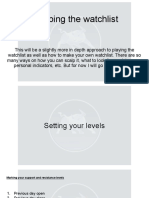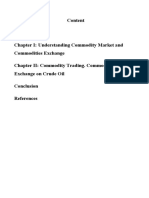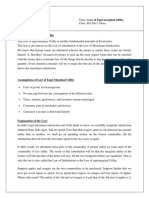Alright bro — deep dive time.
Below I’ll **explain every category and every sub-head** you
asked for: what it is, how to spot it, the psychology behind it, exact trade rules (entry / stop /
targets where applicable), timeframes, confirmations, and common mistakes. I’ve added a
few authoritative citations for the most technical/ratio-heavy parts (harmonics, Elliott rules,
head & shoulders). Read it in chunks — tell me which parts you want charts/mindmaps/PDFs
for next. Let’s go ὒ
# Ultimate detailed guide to trading patterns
---
## 1) Candlestick Patterns Candlesticks show **price action** for a time period (open, high,
low, close). They’re visual tools for short-term setups and often used with higher-timeframe
context.
### Single-candle patterns - **Doji** — open ≈ close (tiny body). - **Psychology:**
indecision between buyers & sellers; context matters (after rally = possible reversal). - **How
to trade:** Wait for confirmation next candle (directional close). Stop a few ticks above/below
the wick. - **Pitfall:** Doji alone is weak.
- **Hammer (bullish) / Hanging Man (bearish)** - **Structure:** small body near top, long
lower wick (≥2× body), little/ no upper wick. - **Psychology:** rejection of lower prices;
buyers stepping in. Hammer at support = reversal signal. - **Trade:** Enter on next candle
close above the hammer high; stop below hammer low; target first resistance or prior swing.
- **Pitfall:** hammer in thin-volume environment can be fake.
- **Shooting Star / Inverted Hammer** — opposite of hammer (long upper wick).
### Two-candle patterns - **Bullish / Bearish Engulfing** - **Structure:** a candle fully
engulfs previous candle body (ignoring wicks). - **Psychology:** strong change of conviction.
- **Trade:** Enter when price continues in engulfing direction; stop below engulfed candle; TP
= measured move or next SR. - **Pitfall:** must engulf bodies, not just wicks.
### Three-candle patterns - **Morning Star / Evening Star** — small indecision candle
between two strong candles of opposite direction; good reversal signals after a trend. -
**Three White Soldiers / Three Black Crows** — 3 consecutive strong candles showing
momentum continuation.
### Confirmation & context - Always check volume, structure (higher highs/lows), and
higher timeframe trend. - Candle patterns are **short-term** signals — typically used on
intraday to daily timeframes.
---
## 2) Chart Patterns (Classical patterns) Formations on price chart that reflect
supply/demand balance over longer durations (hours → weeks).
### Reversal patterns - **Head & Shoulders (H&S;)** (top) / **Inverse H&S;** (bottom) -
**Structure:** left shoulder → higher head → right shoulder (similar to left). Neckline = line
connecting troughs between shoulders. - **Psychology:** trend runs out of buyers;
institutional distribution. - **Entry / Stop / Target:** entry on a **close** below neckline (for
bearish H&S;). Stop ~ above right shoulder. Target = distance (head high − neckline)
projected down from neckline breakout. citeturn0search3 - **Pitfalls:** neckline retests
and false breakouts; small shoulders = weak pattern.
- **Double Top / Double Bottom** - **Structure:** two swings at same level; neckline is
low/high between them. - **Target:** measure height of pattern (peak/trough difference) and
project.
�### Continuation patterns - **Flags & Pennants** - **Context:** strong trend →
consolidation small channel (flag) or small symmetrical triangle (pennant) → continuation. -
**Entry:** breakout in direction of prior trend. Target = length of flagpole projected from
breakout.
- **Triangles (ascending, descending, symmetrical)** - **Symmetrical:** breakout can be
either direction; measure base height and project from breakout for target. - **Ascending /
Descending:** bias toward breakout direction (ascending → bullish bias).
### How to trade classical patterns - Draw pattern accurately (use swing highs/lows). - Wait
for **clear breakout** (close beyond neckline/support/resistance), ideally with **volume
confirmation**. - Use measured move for targets; place stop slightly inside pattern (e.g.,
inside opposite side of breakout) to avoid being stopped by noise.
---
## 3) Harmonic Patterns (Fibonacci-based) Harmonic patterns are **precise geometric
patterns** that use Fibonacci ratios to predict high-probability reversal zones (D point). They
are strict — ratios must roughly match pattern templates.
**Important:** Gartley, Bat, Butterfly, Crab, Shark, Cypher are the most common. Harmonic
rules and ratio setups are strict and described by harmonic traders such as Scott Carney.
citeturn0search4turn0search5
### Key patterns & typical ratios (common reference values) - **Gartley (classic "222")** -
AB ≈ **0.618** of XA. - BC = 0.382–0.886 of AB. - CD ≈ **0.786** of XA (D is the reversal). -
Trade: enter at D (PRZ — Potential Reversal Zone); stop beyond X; TP1 = C, TP2 = B.
citeturn0search1turn0search9
- **Bat** - B near **0.382–0.5** of XA; D near **0.886** of XA. - Smaller than Gartley but
similar entry logic.
- **Butterfly** - B ≈ 0.786 of XA; D is an **extension** (commonly **1.27–1.618** of XA). -
Reversal typically beyond X (an extension pattern).
- **Crab** - Deep extension: D often **1.618** of XA (very extended). High reward but less
frequent.
- **Cypher** - Unique internal ratios (commonly C is 1.272–1.414 of XA and D is ~0.786 of
XC). (Cypher specifics vary by author.)
- **AB=CD (simple harmonic sibling)** - Price segments AB and CD are equal in time/price;
used as confirmation inside other harmonics. citeturn0search0
### How to trade harmonics - **Identify PRZ** (where multiple fib levels converge) → wait
for price reaction (reversal candle, divergence, volume). - **Entry:** conservative = wait for
confirm candle (engulfing, pin, strong close). Aggressive = enter at D. - **Stop:** beyond X or
a safe buffer beyond PRZ. - **Targets:** typical: TP1 = C, TP2 = B, TP3 = A (scale out). -
**Timeframes:** swing traders — 4H, daily preferred; patterns may appear on intraday too. -
**Pitfalls:** patterns require strict ratio checks; overfitting is common — don’t force patterns
that don’t fit.
---
## 4) Wave Patterns (Elliott Wave Theory) Price moves in fractal waves — **motive**
(impulse) 5-wave moves and **corrective** 3-wave moves. Used for structure / counting and
forecasting.
�### Core rules (cardinal rules) - Wave 2 cannot retrace beyond the start of Wave 1 (i.e.,
cannot go past 100% of Wave 1). - Wave 3 **can never** be the shortest of Waves 1, 3, and
5. - Wave 4 cannot overlap price territory of Wave 1 (in a standard impulse). These are the
core rules to validate an impulse count. citeturn0search6turn0search11
### Structure - **Impulse (5-wave)**: 1 (up), 2 (pullback), 3 (strongest), 4 (shallow
pullback), 5 (final push). - **Corrective (3-wave)**: A–B–C; can be zigzag, flat, triangle, or
combinations (complex corrections).
### Trading with Elliott - **Counting matters**: label waves across timeframes. - Use
**Fibonacci** for wave relationships — e.g., Wave 3 often 1.618× Wave 1, Wave 5 may equal
Wave 1 or be 0.618× Wave 3. - Trade near **wave extensions & retracement levels**; e.g.,
enter on Wave 2 completion for Wave 3 ride. - **Pitfalls**: subjective wave labeling,
re-labeling often required; use other confirmations (momentum, volume).
---
## 5) Price Action / Support-Resistance Patterns Pure price reading without (or with minimal)
indicators. Focus on structure, order blocks, and levels.
### Key concepts - **Support & Resistance (SR)** — horizontal levels where price
historically stalled. - **Breakouts** — price closes beyond SR; trade after a confirmed close +
volume. - **Pullbacks / Retests** — after breakout, price often retests the broken level; retest
is better risk/reward entry. - **Supply & Demand zones / Order Blocks** — wider areas where
institutions accumulated/distributed. Look for rejection candles within these zones.
### How to trade - Identify higher timeframe SR first. - Prefer entries on **retest** with
rejection candle + lower timeframe confirmation. - Stop just beyond the SR zone; TP at next
SR/structure or measured move. - **Pitfalls:** breakout traps; avoid entering solely on first
breakout without confirmation.
---
## 6) Indicator-Based Patterns Using indicator behavior to form trade decisions (not patterns
in price itself, but patterns in the indicator).
### Common indicator signals - **MA Crossovers** - Golden Cross (short MA crosses above
long MA = bullish), Death Cross opposite. - Work best on daily/week timeframes; lagging
signal.
- **RSI Divergence** - Price makes higher highs while RSI makes lower highs → bearish
divergence (weakening momentum). - **Bullish divergence** is the reverse. Use as a
warning/confirmation, not sole entry.
- **MACD** - Crossovers of MACD line & signal line; MACD histogram divergence.
- **Bollinger Bands** - **Squeeze** (low volatility) often precedes expansion/breakout. -
Stochastics/RVI for overbought/oversold signals combined with zone structure.
### How to trade - Always combine indicator signals with price structure
(support/resistance). - Indicators are lagging; use momentum indicators for timing and MA/BB
for trend context.
---
## 7) Volume Patterns Volume confirms or contradicts price moves — a vital secondary
input.
### Key patterns/uses - **Volume Spike / Climax** — extreme volume often marks
exhaustion (tops or bottoms). - **Volume Divergence** — price making new highs on lower
�volume = weak; beware reversal. - **Accumulation / Distribution (OBV, VWAP)** — sustained
buying/selling hinted by on-balance volume or accumulation.
### How to trade - Use volume to confirm breakouts: breakout + rising volume = stronger
signal. - For reversals, look for high-volume reversal day with price rejection (long wick +
spike).
---
## 8) Fractal & Geometric Patterns Look for self-similar structures or geometric symmetry.
### Fractals (Bill Williams) - Identifies local swing highs/lows by a pattern of five bars (high
in center higher than two either side). Useful for local stops/targets.
### Geometric symmetry / measured moves - **Measured Move** — segment length from
previous leg projected to estimate the next leg (common in symmetric ranges). - **Pitchfork /
medianline** tools fall under geometric approaches (see section 12).
---
## 9) Algorithmic / Quantitative Patterns Patterns discovered or traded by code, statistical
models, or ML.
### Types - **Pairs trading / Statistical arbitrage** — mean reversion across correlated
assets. - **Quant signals** — e.g., factor-based momentum reversal, volatility breakout
algorithms. - **ML pattern recognition** — neural nets detect subtle chart shapes not
obvious visually.
### How traders use them - Backtest extensively — these are data-driven, not eyeballed.
Risk controls and overfitting checks are critical. - Best for firms/traders with systematic edge
and access to clean data.
---
## 10) Cycle & Time Patterns Time-based repetitions and market cycles.
### Key ideas - **Market cycle stages:** Accumulation → Mark-up (trend) → Distribution →
Mark-down. Use macro context to decide long/short bias. - **Gann / Time cycles:** Gann
theory uses angles and time cycles (advanced & esoteric). - **Seasonality:** recurring
calendar effects (e.g., month-of-year, holiday effects). Useful for statistical bias rather than
single-trade signals.
### How to trade - Combine cycle awareness with price structure (e.g., if in distribution
stage, favor shorts on rallies). - Time cycles require dedicated study; treat as supplemental.
---
## 11) Order Flow / Market Microstructure Patterns Pro traders use order book & tape data
(DOM, Time & Sales) to see real buying/selling pressure.
### Concepts - **Absorption** — large orders absorb market pressure without price moving
(indicates strong hidden interest). - **Iceberg orders** — large hidden orders visible as
repeated small prints at certain prices. - **Spoofing (illegal)** — fake orders to move price;
recognize and avoid. - **Delta (buy vs sell volume)** — shows who’s in control at each price.
### How to trade - Order flow requires live Level II / DOM and fast execution. Trades often
**scalps** or very short-term. - Use to confirm breakouts (aggressive buying hitting offers) or
to detect exhaustion (aggressive selling but price flat).
---
�## 12) Chart Geometry / Advanced Technical Patterns Tools & geometry-based setups for
precision targeting.
### Tools & patterns - **Fibonacci retracement & extension** — identify pullback levels
(38.2%, 50%, 61.8%) and target extensions (127.2%, 161.8%). - **Andrews’ Pitchfork** —
trend channel around a median line; price tends to gravitate to median. - **Gann Angles** —
slope-based support/resistance lines (angles). - **Wolfe Waves** — 5-wave reversal pattern
that gives a precise target (line from points 1→4 projected to 5). - **Measured/Proportional
targets** — use geometry to set targets and stops.
### How to use - These tools provide structure and objective targets. Combine with
confluence (Fibs + SR + pattern) for higher probability.
---
# Practical checklist — how to trade a pattern (generic steps) 1. **Identify** the pattern on a
clean chart (use higher timeframe to set context). 2. **Validate** pattern rules (ratios for
harmonics, wave rules for Elliott, proper swing points for H&S;). 3. **Confirm** with at least
one secondary tool: volume, RSI divergence, order flow, or a lower-timeframe reaction. 4.
**Entry:** conservative = wait for confirmation candle/retest; aggressive = at pattern
completion (D point / neckline break). 5. **Stop:** place beyond logical invalidation point (X
for harmonic, head/shoulder high, below support). 6. **Targets:** use measured move, fib
extension, or scale out at multiple levels. 7. **Risk management:** risk a fixed % per trade;
use RR (aim >1.5–2:1) and consider volatility (ATR) for stop sizing. 8. **Journal & backtest**:
track win rate, expectancy, and slippage.
---
# Reliability & timeframe cheat-sheet (quick) - **Candlesticks:** intraday → daily; reliability:
**low–medium** alone. - **Chart patterns (H&S;, triangles):** 4H → daily; **medium–high** if
confirmed by vol. - **Harmonics:** 4H → daily; **medium–high** if ratios strict + price
reaction in PRZ. citeturn0search5 - **Elliott Waves:** daily → weekly; **subjective** but
powerful if counted correctly. citeturn0search6 - **Price action / SR:** any timeframe;
**high** when using higher-timeframe SR + retest. - **Indicator patterns:** all timeframes;
**medium** (lagging). - **Volume patterns:** all timeframes; **high** for confirmation. -
**Order flow:** very short-term (scalps); **high** for pros with data. - **Algo/quant:**
depends on backtest; **high** when robust and not overfitted.
---
## A few important cautions (real-talk) - **No pattern is 100%** — use confluence (2–3
supports). - **Don’t force-fit** a pattern: if rules aren’t met, skip it. - **Backtest** your exact
entry/exit rules on historical data/timeframes you trade. - **Adapt to market regime** —
patterns behave differently in trending vs choppy markets.
---
### Sources for the most technical items (harmonics & wave rules & H&S; targets) - Gartley
& harmonic ratios guidance: IG / trading harmonic references.
citeturn0search1turn0search9 - Harmonic ratio theory & derived ratios (Scott Carney
references). citeturn0search4 - Elliott Wave cardinal rules & guidelines.
citeturn0search6turn0search11 - Head & Shoulders target method (measure
head-to-neckline projection). citeturn0search3
---
That’s the full, **in-depth** breakdown for every head + subhead. Want me to: - Convert this
into a **one-page cheat sheet PDF**? - Update the **mindmap** with these subheads and
�add quick trade rules under each node? - Make example charts (images) showing each
pattern on real price charts?
Tell me which one and I’ll make it right away, bro.





















































































